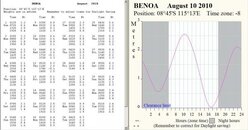Hi all,
Im currently working as a DM in the Gili islands. Guiding is fun with a good range of dive sites but some of the better sites are very dependent on the currents and tides. There is constantly difference of opinion about whether we should venture to a site on a given day and I'd like to be a bit more scientific.
Sadly this seems hard in the area - tides seem unpredictable and can go from high to a bit lower to high again all within a few hours before a massive low tide just a few hours after that.
Surface conditions and deep currents have little correlation.
The islands sit in the Lombok straight which serves as one of two main through flows from the pacific to Indian oceans.
My questions:
1. Does anyone have any experience of this area and has tried to figure this out before?
2. Is a rising tide and different to a falling tide with regards effect on currents?
3. What could be the likely contributors to high/low tide period irregularity?
Thanks very much in advance
Im currently working as a DM in the Gili islands. Guiding is fun with a good range of dive sites but some of the better sites are very dependent on the currents and tides. There is constantly difference of opinion about whether we should venture to a site on a given day and I'd like to be a bit more scientific.
Sadly this seems hard in the area - tides seem unpredictable and can go from high to a bit lower to high again all within a few hours before a massive low tide just a few hours after that.
Surface conditions and deep currents have little correlation.
The islands sit in the Lombok straight which serves as one of two main through flows from the pacific to Indian oceans.
My questions:
1. Does anyone have any experience of this area and has tried to figure this out before?
2. Is a rising tide and different to a falling tide with regards effect on currents?
3. What could be the likely contributors to high/low tide period irregularity?
Thanks very much in advance





